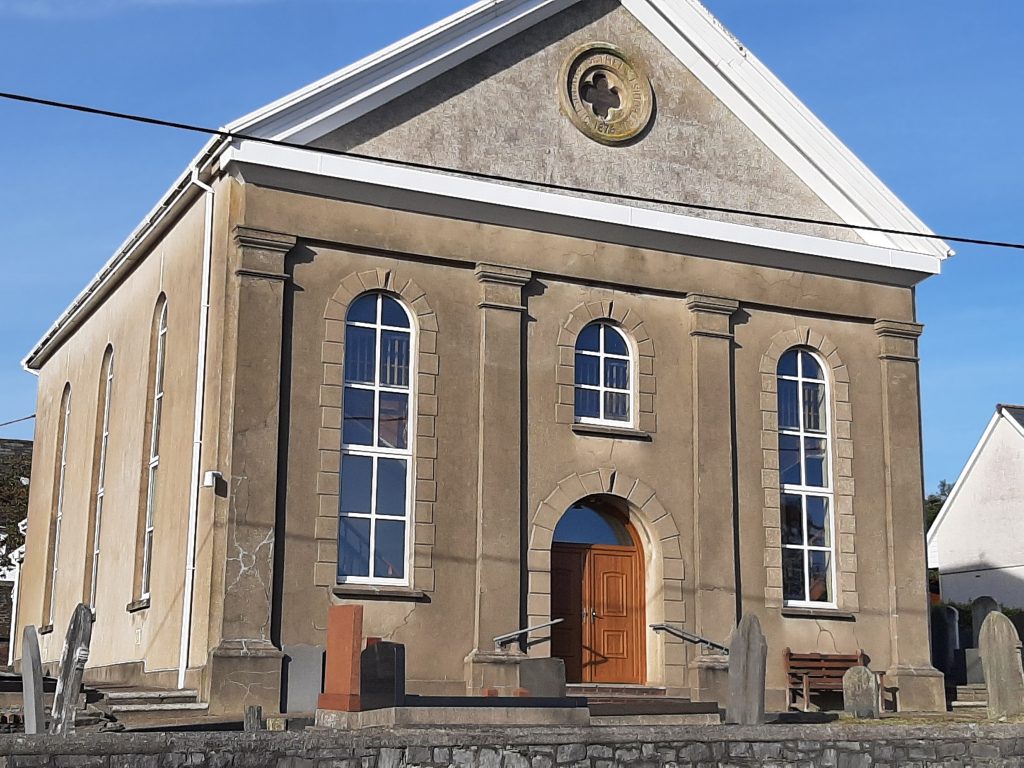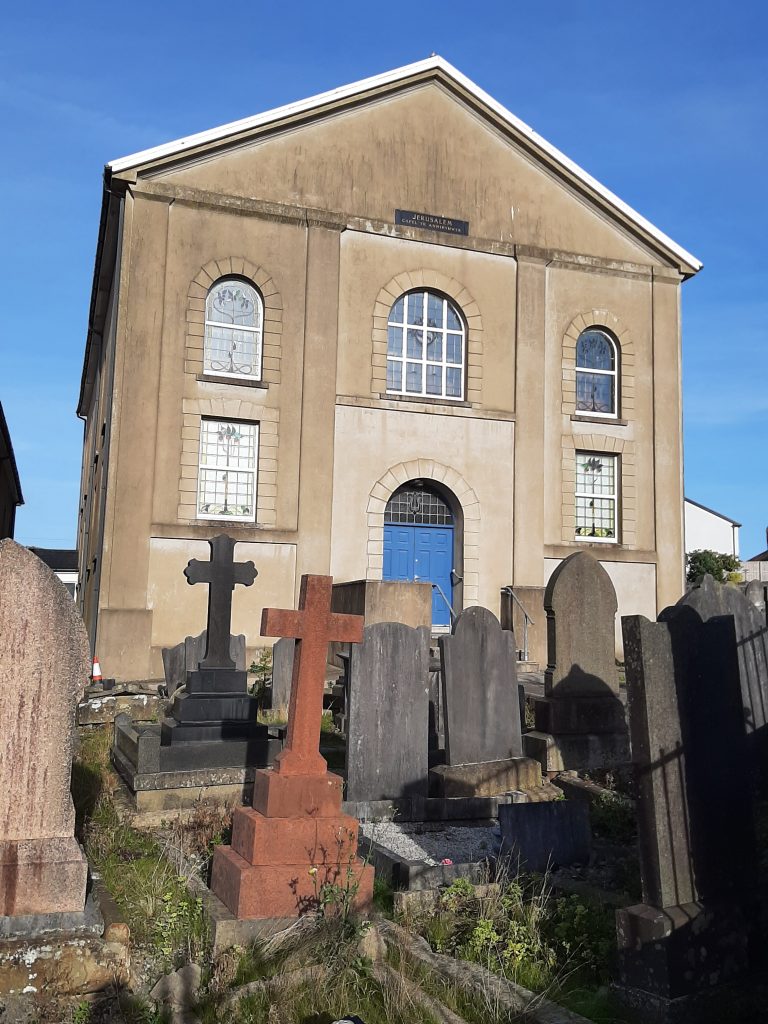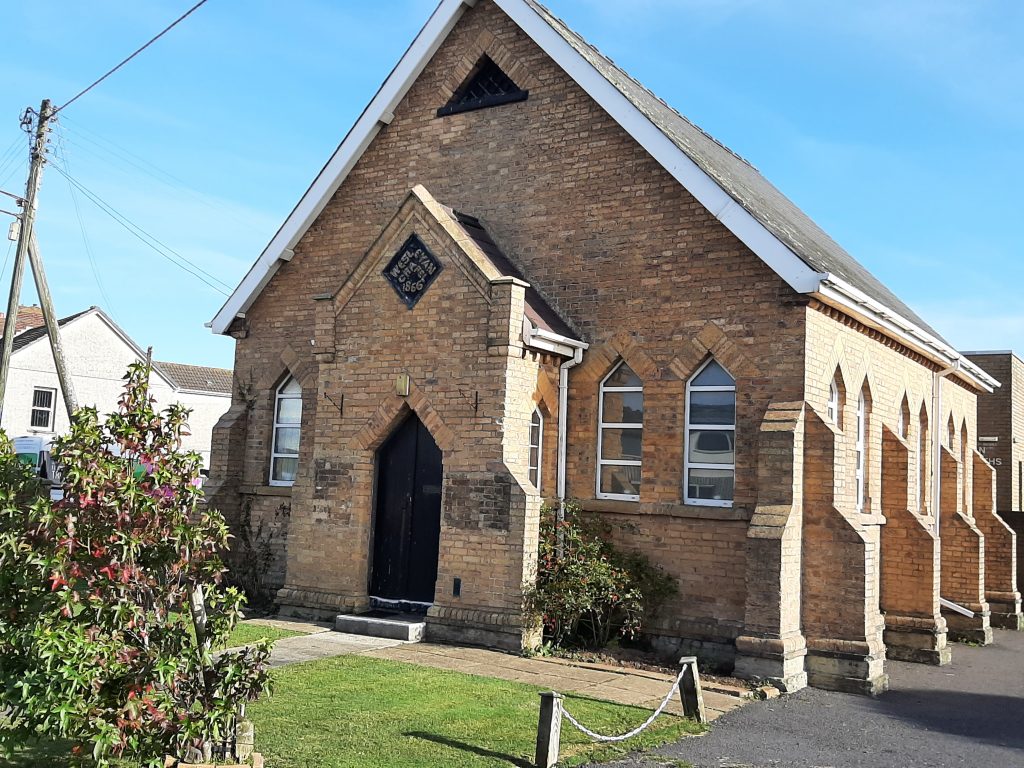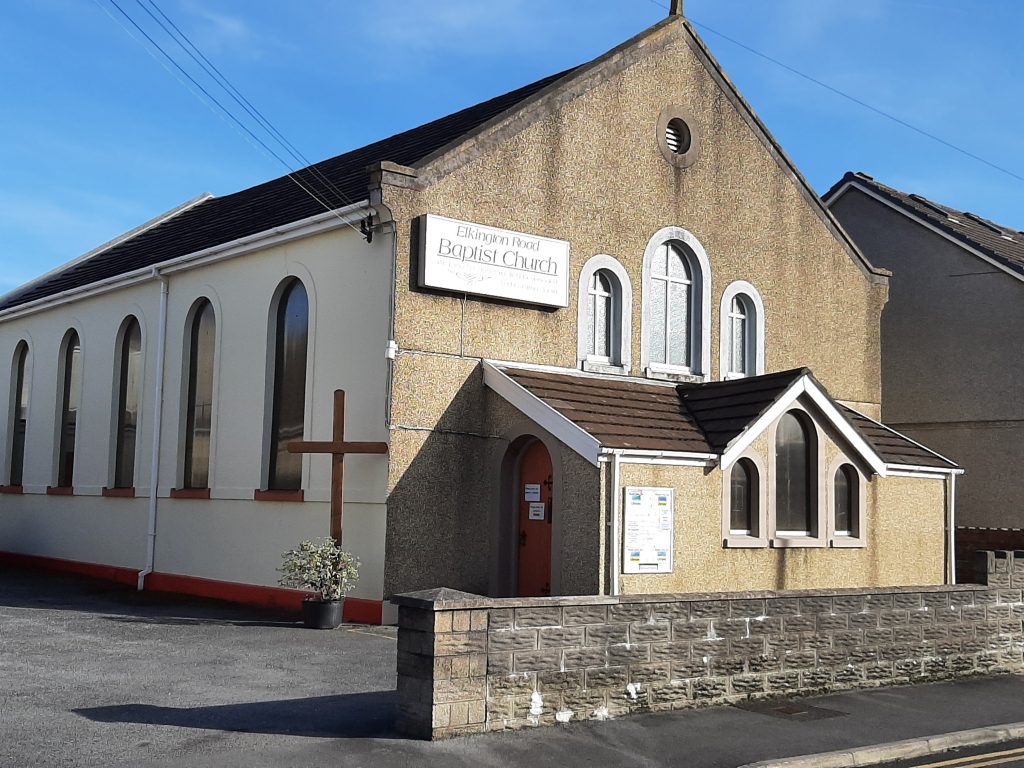NONCONFORMITY PART 2 THE CHAPELS OF PEMBREY AND BURRY PORT
Nonconformists are those members of churches which did not conform to the teaching and practices of the Anglican church. Also called ‘Dissenters’, their chapels, built largely in the 19th century, can still be seen in Pembrey and Burry Port although many are empty or used for other purposes. These early movements have their roots in the Puritanism of the 16th century which arose as a result of dissatisfaction with the Church of England’s ceremonies and practices which were regarded as too close to the Roman Catholic church. They wished to see a purer form of Christianity based on the teaching of the Bible. Each denomination had some distinctive features. They include Independents or Congregationalists, Baptists, Unitarians. Quakers, Calvinistic Methodists or Presbyterians and Wesleyan Methodists. This article explores the origins of some of the main chapels in Pembrey and Burry Port with a brief description of the beliefs of the different denominations.
BETHEL CALVINISTIC METHODIST (now Welsh Presbyterian), Pembrey (1812)
Bethel was an early small chapel built in 1812 and the first in the parish, enlarged in 1850 and rebuilt in 1876 which is the current building. A piece of land was leased from a local farmer, John Rogers, for an annual rent of £1.50. During the first half of the 18th century Calvinistic Methodism was strong in South Wales and missionary preachers led many meetings in the Pembrey area in houses and farms and outdoors. Initially there was no permanent minister but from 1821 three unpaid local ministers were the preachers: Rev. Josiah Evans, Rev. Dafydd Wales and Dafydd Rogers.

The Blue Books of 1847 stated that the Sunday school had 97 scholars of which 40 could read the scriptures and there were 6 male and 4 female teachers. The 1851 Religious Census described 250 seats used for pew rental, 30 free and space for 100 standing. The attendance figures describe an afternoon school of 280 plus 70 scholars and evening congregation of 291 plus 76 scholars.
The Methodists
The forerunner of Calvinistic Methodism (now called ‘Presbyterianism’) was Griffith Jones, the rector of Llanddowror, Carmarthenshire whose circulating schools taught thousands in Wales to read in Welsh and whose outdoor powerful preaching facilitated the Methodist revival. However, the main early leaders were Howell Harris from Trefecca (1714-1773) and Daniel Rowland from Llangeitho (1713-1790). The Calvinistic Methodists demonstrated a passion for biblical doctrine and followed the teaching of John Calvin, the Protestant reformer of Geneva. Calvin is best known for his emphasis on predestination, the belief that God would save the ‘elect’ who were predestined to eternal life. Calvin’s view of the importance of feelings over intellectualism is reflected in the Methodist emphasis on personal devotion and experience, a theology for the heart. Another early leader, William Williams Pantycelyn, was converted as a result of Harris preaching in Talgarth churchyard. He later became an eminent writer and composer of hymns, with probably his best known ‘Guide me, O thou great Jehovah’.
The early Methodists were evangelical and attracted large enthusiastic crowds, many of whom were converted and became evangelists themselves. Howell Harris made many visits to Carmarthenshire and it was not unusual for members of the Anglican church to try to break up the meetings. However, they remained part of the Anglican church wishing to revive it and not abandon it, until eventually in 1811 they separated from the established church.
JERUSALEM WELSH INDEPENDENT CHAPEL (1812)

The first chapel was built in 1812 on land bought from Dan y Graig Farm, although previously meetings had been held in Goodig Fach, Pant and some people had walked to Capel Als in Llanelli (which was linked and shared a minister) to take communion. The beginnings were unsettled with some opposition in the town to Nonconformism and a dispute within the congregation over their second minister, Rev. Davies. The disagreement led to the establishment of another Independent chapel, Carmel, which was built in 1828. Some stability was restored when Rev. Henry Evans, minister of Carmel, was invited to be in charge of both chapels in 1842.
The Blue Books of 1847 state that in the Sunday School there were 55 scholars (25 boys, 30 girls) under 15 years and 21 over 15 with 10 teachers (10 male, 2 female).
The 1851 Religious Census described 174 seats used for pew rental and 175 others. It suggests that the average adult attendance was 168 in the afternoon and 197 in the evening. The Census also recorded 435 Independent places of worship, 13 of them in Llanelli. The Baptists and Independents were at this time the strongest congregations. The numbers reflect the influx of workers into the area during the growth of the local industries and consequently a new chapel was opened in 1858. This was extended in 1888 during the lengthy and energetic ministry of Rev. John Rogers (1871-1915). A strict teetotaller, he was very active in the community as an advocate of abstinence and established a working men’s club.
The chapel had a strong tradition of music and especially choral singing despite the absence of an organ, regarded by some as ‘the devil’s instrument’. The Cymanfa Ganu or ‘singing festival’ was a regular feature. The increase in the number of adults and Sunday school scholars (over 500 at the end of the 19th century) attending the chapel resulted in the addition of a vestry which opened in 1901.
The Independents
The first Independent congregation in Wales was at Llanfaches in Monmouthshire and was set up in 1639 by the rector of the parish, William Wroth. His missionary energy led also to the establishment of another congregation in Cardiff. Initially meetings took place in houses and barns or out of doors but the Toleration Act of 1689 allowed the dissenters to build their own chapels. The first one at Llanfaches does not now exist, but the place is still sometimes described as the ‘Jerusalem of Wales’. The earliest surviving Independent chapel in Wales is Maesyronnen, near Glasbury, Powys.
Towards the end of the 18th century there were about 100 Independent congregations in Wales and 46 Independent ministers. The English speaking congregations and some Welsh became part of the Congregational Union of England and Wales in 1832 and most of the Welsh speaking churches joined the Union of Welsh Independents (Undeb yr Annibynwyr Cymraeg) in 1871. (Later most of the English-speaking Congregationalists in Wales and England joined the Presbyterian Church of England to form the United Reformed Church in 1972) The Undeb was established in Swansea and its first annual meetings were held at Carmarthen in 1872. Churches in the Undeb are in a voluntary relationship with each other.
The 1851 Religious Census recorded 435 Independent places of worship, 13 of them in Llanelli. The Baptists and Independents were at this time the strongest congregations.
The name of the Union headquarters – Ty John Penri – reflects the origins of the movement in the early Nonconformist pioneers. John Penry, born in Llangamarch, campaigned for more preaching in Wales and a Welsh Bible, and his publications and activities led to his arrest and execution. The Independents have always placed emphasis upon on the Bible, preaching the Gospel, education, and the empowerment of its members. Today there are around 370 member churches in all parts of Wales.
ENGLISH METHODIST CHAPEL (1866) – Glanmor Terrace, Burry Port.

The brick-built chapel was completed in 1866 in an area at the heart of the town’s industrial development – copper works, railway etc – and was certified as a place of worship on the 29th November 29 of the same year. The owners of the Copper Works had built nearby houses for their workers and it seems that the adjacent Burry Port Smelting Company (which smelted lead and silver) had also contributed to the building of Silver terrace (then Silver Row).
Cornish workmen with experience of the ores came to work in the smelting company and many had a strong Methodist background. Consequently, in December 1866 an indenture was drawn up between the smelting company, which owned the land, with twelve local men (from Llanelli and Pembrey) to lease the land for 72 years (one shilling a year), on the condition that the chapel was built within 18 months.
The freehold of the land was bought in 1915 for the sum of £25 and the minister at the time loaned the Trustees £100 enabling necessary alterations and rebuilding. After some serious fund-raising in 1934 a schoolroom was built of wood joining the larger building for the price of £176. This hall was demolished in 2009 and, during the ministry of Rev. Pauline Barnett, replaced by a modern community hall funded through various sources and named the Leslie Griffiths Centre after Rev. Dr Leslie Griffiths – a member of the House of Lords (Lord Griffiths of Burry Port) and in his youth a member of the church.
Wesleyan Methodists
Wesleyan Methodism owes its name to John Wesley one of the leaders of what was knick-named the Holy Club in Oxford University in the 1720s, a study group looking systematically at the Bible, exploring personal devotion and praying regularly. They also visited people in jail.In 1738Wesley had a conversion experience in which his heart was ‘strangely warmed’ which led to an itinerant preaching ministry in which he set up small groups and appointed other travelling evangelists.
The early Methodists were characterised by outdoor preaching and evangelism, caring for the poor and those who were on the margins of society. Wesley and his followers also rejected the Calvinist doctrine of predestination and salvation for the elect and accepted the Arminian belief that salvation was open to all. When working-class people were not being catered for by the Church of England Wesley encouraged labourers to study the Bible and wanted the poor to be educated. Because Wesley did not speak Welsh his impact was largely upon English speakers but later the British Wesleyan Conference sent Welsh speaking preachers to Wales.
Wesley on his travels passed through Carmarthenshire at least fifteen times, but the people were largely Welsh speaking and he did not achieve much success, although he was made welcome in Llanelly by Sir Thomas Stepney where his butler, Wilfred Cully, was one of the leaders of the Society formed there. In his journal Wesley called Cully the “father of the Society” in Llanelly and he visited the town on numerous occasions where he preached to large number of people where, despite the use of English, “the preacher’s earnestness and fire carried with them their own interpretation”.
The 1851 Religious Census recorded that there were 499 Wesleyan places of worship in Wales with the attendance at Sunday services 53,730. In Llanelli, with a population of 23,500 there were 5 Wesleyan places of worship and about 1000 in attendance. There was no intention to break from the Church of England but to revive it, although the Wesleyan Methodists did ultimately separate at the end of the 19th century.
ELKINGTON ROAD ENGLISH BAPTIST (1913)

Daughter church of Tabernacle Welsh Baptist Church, it began its life in a shed near the railway line. The English Baptists moved to this building in 1913 where it still meets. The building served as the town’s first secondary school.
A local newspaper report stated: “A separate building, duly certified for Religious Worship named English Baptist Church situated at Elkington Road, Burry Port, in the Civil Parish of Burry Port Urban, in the County of Carmarthen, in the Llanelly Registration district, was, on the 11th January, 1913, registered for solemnizing Marriages therein…” It was then the English Baptists moved into their new and present building.
Before their first building of 1897 the English Baptists held their services in a shed on open land in front of, and roughly between, the Co-operative Stores (before the bridge was built) and the chip shop, then known as the Jubilee Shop (built during Victoria’s Jubilee Year 1887).
Their next move in 1897 was to a building at the rear of Mr Thomas William’s grocery shop at the join of Stepney Road and Pencoed Road. Described as ‘A zinc-sheeted chapel with Gothic details’ it was known as Stepney Road Baptist Chapel. After the Baptists left the building it was used as a cinema – known as Sinema Twm after its owner. Both buildings are now demolished.
The first secondary school (Burry Port Central School) was held at the English Baptist church in Elkington Road. The school moved to a new building in Furnace Fields near Pemberton Ave. in 1933. After the 1939/45 war it became Burry Port Secondary Modern School and in 1977 PortH Tywyn Comprehensive School.
Baptists
Baptists derived from an Anabaptist community in Amsterdam and the early leaders were John Smyth and Thomas Helwys. Smyth rejected the practice of baptising infants and introduced the baptism of believing adults. This is the distinctive feature of Baptist churches, although each fellowship is autonomous. Baptism was conducted in streams, rivers, the sea and more recently in a baptismal pool inside a chapel. Each Baptist church can appoint its own ministers, deacons and officers and conduct its own administration. However, most have links with local associations of Baptist churches.
The first Baptist fellowship in Wales was established near Swansea in 1649 and the first in west Wales was near Narberth in 1668. This was at a time when it was illegal for dissenters to meet for public worship and some were fined and imprisoned. The early Baptists were Calvinistic in theology – called Particular Baptists – believing in predestination and salvation of the elect. The General Baptists believed that Christ’s salvation was available to all.
Baptists today are mostly evangelical in theology and, although they would place emphasis on the authority of the Bible for their faith and practice, traditionally they enjoy individual religious freedom and liberty of conscience. Baptism is not regarded as a sacrament (it does not impart divine grace) but is described as ordinance, a ritual to be observed which was instituted by Jesus Christ.
OTHER CHAPELS IN PEMBREY AND BURRY PORT
- HERMON WESLEYAN CHAPEL, Pembrey. Was originally ‘Ebenezer’, built in 1832. The congregation moved to a nearby site in 1858 and it was renamed ‘Hermon’.
- BETHANY CALVINISTIC METHODIST, New Street. (1861)
- SEION INDEPENDENT CHAPEL, Parc-y-Minos, Burry Port.(1873)
- TABERNACLE WELSH BAPTIST. Seaview Terrace, Burry Port. (1856)
- CARMEL WELSH INDEPENDENT, Burry Port (1828)
- ENGLISH CONGEGATIONAL CHURCH, Parc-Y-Minos, Burry Port (1870)
